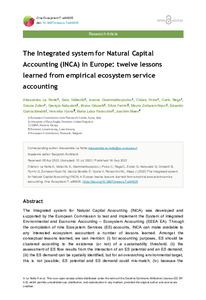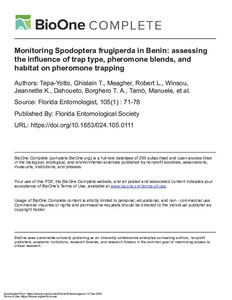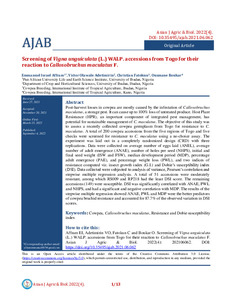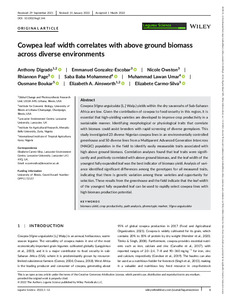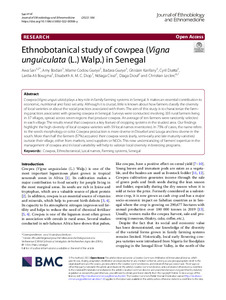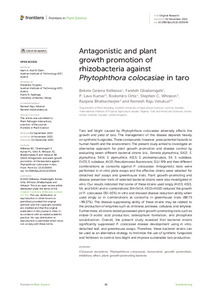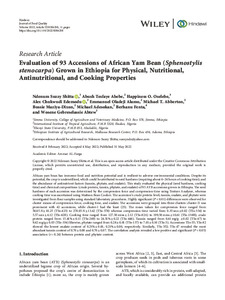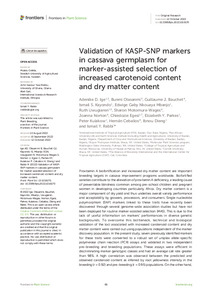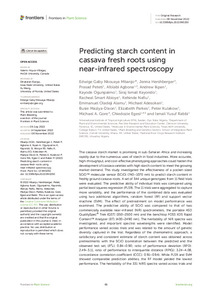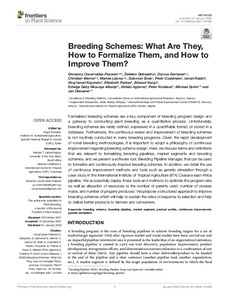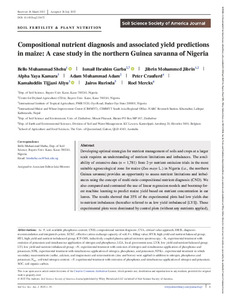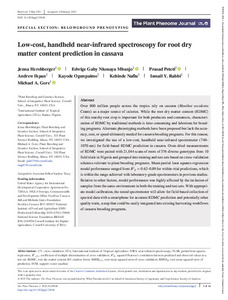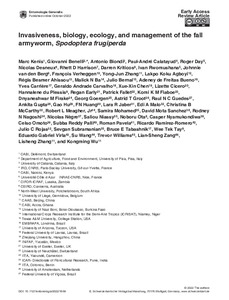Welcome to the International Institute of Tropical Agriculture Research Repository
Journal and Journal Articles: Recent submissions
Now showing items 341-360 of 5157
-
Yield stability of east African highland cooking banana 'Matooke' hybrids
(2022-12-08)East African banana (Musa sp.) breeding efforts have focused mainly on enhancing ‘Matooke’ productivity through the development of high-yielding, pathogen-resistant cultivars with adequate stability to contribute to regional food security. Before a breeding program can recommend promising cultivars for release, they must pass the sensory screens; be evaluated in the target population environments; and the data analyzed for yield, adaptability, and stability. Twenty-four primary and secondary ... -
The Integrated system for Natural Capital Accounting (INCA) in Europe: twelve lessons learned from empirical ecosystem service accounting
(2022-09-16)The Integrated system for Natural Capital Accounting (INCA) was developed and supported by the European Commission to test and implement the System of integrated Environmental and Economic Accounting – Ecosystem Accounting (SEEA EA). Through the compilation of nine Ecosystem Services (ES) accounts, INCA can make available to any interested ecosystem accountant a number of lessons learned. Amongst the conceptual lessons learned, we can mention: (i) for accounting purposes, ES should be clustered ... -
Monitoring Spodoptera frugiperda in Benin: assessing the influence of trap type, pheromone blends, and habitat on pheromone trapping
(2022-12-12)The fall armyworm, Spodoptera frugiperda (J. E. Smith) (Lepidoptera: Noctuidae), has now become a pest of global concern. Originally known to be endemic to the Western Hemisphere, its first detection in Africa was followed by spectacular outbreaks and spread to almost all sub-Saharan countries. The rapid incursion of S. frugiperda on maize (Zea mays L.; Poaceae) fields in Africa highlighted a crucial need for a comprehensive assessment of integrated pest management strategies in most smallholder ... -
Data-driven similar response units for agricultural technology targeting: an example from Ethiopia
(2022-07-25)Ethiopia has heterogeneous topographic, climatic and socio-ecological systems. Recommendations of agricultural inputs and management practices based on coarse domains such as agro-ecological zones (AEZ) may not lead to accurate targeting, mainly due to large intra-zone variations. The lack of well-targeted recommendations may contribute to the underperformance of promising technologies. Therefore, there is a need to define units where similar environmental and biophysical features prevail, based ... -
Phenotyping cowpea for seedling root architecture reveals root phenes important for breeding phosphorus efficient varieties
(2022-02)Cowpea (Vigna unguiculata L. Walp.) is a key climate-resilient legume for food security, especially in sub-Saharan Africa. Cowpea yields are limited by edaphic stresses including drought and low phosphorus (P) availability. Identifying genotypes with advantageous root phenotypes can facilitate breeding for improved yield in marginal environments. We evaluated 50 elite genotypes from African and U.S. sources for seedling root architecture and root hair length and density. Significant genotypic ... -
Screening of Vigna unguiculata (L.) WALP. accessions from Togo for their reaction to Callosobruchus maculatus F.
(2022-09-04)Post-harvest losses in cowpea are mostly caused by the infestation of Callosobruchus maculatus, a storage pest. It can cause up to 100% loss of untreated produce. Host Plant Resistance (HPR), an important component of integrated pest management, has potential for sustainable management of C. maculatus. The objective of this study was to assess a recently collected cowpea germplasm from Togo for resistance to C. maculatus. A total of 200 cowpea accessions from the five regions of Togo and five ... -
Cowpea leaf width correlates with above ground biomass across diverse environments
(2022-03-21)Cowpea (Vigna unguiculata [L.] Walp.) yields within the dry savannahs of Sub-Saharan Africa are low. Given the contribution of cowpea to food security in this region, it is essential that high-yielding varieties are developed to improve crop productivity in a sustainable manner. Identifying morphological or physiological traits that correlate with biomass could assist breeders with rapid screening of diverse germplasm. This study investigated 23 diverse Nigerian cowpea lines in an environmentally ... -
Ethnobotanical study of cowpea (Vigna unguiculata (L.) Walp.) in Senegal
(2022)Cowpea (Vigna unguiculata) plays a key role in family farming systems in Senegal. It makes an essential contribution to economic, nutritional and food security. Although it is crucial, little is known about how farmers classify the diversity of local varieties or about the social practices associated with them. The aim of this study is to characterize the farming practices associated with growing cowpea in Senegal. Surveys were conducted involving 335 rural farmers living in 37 villages, spread ... -
Antagonistic and plant growth promotion of rhizobacteria against Phytophthora colocasiae in taro
(2022)Taro leaf blight caused by Phytophthora colocasiae adversely affects the growth and yield of taro. The management of this disease depends heavily on synthetic fungicides. These compounds, however, pose potential hazards to human health and the environment. The present study aimed to investigate an alternative approach for plant growth promotion and disease control by evaluating seven different bacterial strains (viz., Serratia plymuthica, S412; S. plymuthica, S414; S. plymuthica, AS13; S. ... -
Diversity and taxonomy of the fern genus Vandenboschia Copel. (Hymenophyllaceae, Polypodiidae) in the Afro-Malagasy region and description of a new species
(2022)Vandenboschia radicans (supposedly Neotropical and African), V. speciosa (supposedly European and Macaronesian) and V. gigantea (supposedly from western Indian Ocean) are morphologically close species and often confused in collections and in floras. Moreover, the status of African populations is still strongly debated. We undertook to combine morphological, morphometrics and molecular phylogenetic analyses, on these three species, by also including the Neotropical V. collariata, morphologically ... -
Genotype X environment interaction and stability analysis in upland rice (Oryza sativa L.) varieties in Ethiopia
(2022)Determination of the genotype x environment interaction (GEI) and stability of upland rice varieties for grain yield provides the basis to identify high-yielding and stable upland rice varieties across different environments and to delineate and identify rice mega environments in Ethiopia. Twenty rice varieties were laid out in a randomized complete block design with three replications and evaluated across six locations that represent the major rice growing agro-ecologies in the country. The ... -
Evaluation of 93 accessions of African yam bean (Sphenostylis stenocarpa) grown in Ethiopia for physical, nutritional, antinutritional, and cooking properties
(2022)African yam bean has immense food and nutrition potential and is resilient to adverse environmental conditions. Despite its potential, the crop is underutilized, which could be attributed to seed hardness (requiring about 6–24 hours of cooking time); and the abundance of antinutrient factors (tannin, phytate, and oxalate). This study evaluated the physical (seed hardness, cooking time) and chemical compositions (crude protein, tannin, phytate, and oxalate) of 93 AYB accessions grown in Ethiopia. ... -
Tolerance to soil acidity of soybean (Glycine max L.) genotypes under field conditions Southwestern Ethiopia
(2022)Soil acidity with associated low nutrient availability is one of the major constraints to soybean production in southwestern Ethiopia. Integrated use of lime and acid-tolerant crops is believed to reduce soil acidity and improve crop production. The experiment was conducted in the field condition of Mettu, southwestern Ethiopia during the 2017/18 main cropping season. The experiment comprised fifteen soybean genotypes and two soil amendment (lime and unlimed) treatments arranged in a split-plot ... -
Validation of KASP-SNP markers in cassava germplasm for marker-assisted selection of increased carotenoid content and dry matter content
(2022)Provitamin A biofortification and increased dry matter content are important breeding targets in cassava improvement programs worldwide. Biofortified varieties contribute to the alleviation of provitamin A deficiency, a leading cause of preventable blindness common among pre-school children and pregnant women in developing countries particularly Africa. Dry matter content is a major component of dry yield and thus underlies overall variety performance and acceptability by growers, processors, and ... -
Predicting starch content in cassava fresh roots using near-infrared spectroscopy
(2022)The cassava starch market is promising in sub-Saharan Africa and increasing rapidly due to the numerous uses of starch in food industries. More accurate, high-throughput, and cost-effective phenotyping approaches could hasten the development of cassava varieties with high starch content to meet the growing market demand. This study investigated the effectiveness of a pocket-sized SCiO™ molecular sensor (SCiO) (740−1070 nm) to predict starch content in freshly ground cassava roots. A set of 344 ... -
Breeding schemes: what are they, how to formalize them, and how to improve them?
(2022)Formalized breeding schemes are a key component of breeding program design and a gateway to conducting plant breeding as a quantitative process. Unfortunately, breeding schemes are rarely defined, expressed in a quantifiable format, or stored in a database. Furthermore, the continuous review and improvement of breeding schemes is not routinely conducted in many breeding programs. Given the rapid development of novel breeding methodologies, it is important to adopt a philosophy of continuous ... -
Compositional nutrient diagnosis (CND) and associated yield predictions in maize: a case study in the northern Guinea savanna of Nigeria
(2022)Developing optimal strategies for nutrient management of soils and crops at a larger scale requires an understanding of nutrient limitations and imbalances. The availability of extensive data (n = 1,781) from 2-yr nutrient omission trials in the most suitable agroecological zone for maize (Zea mays L.) in Nigeria (i.e., the northern Guinea savanna) provides an opportunity to assess nutrient limitations and imbalances using the concept of multi-ratio compositional nutrient diagnosis (CND). We also ... -
Low-cost, handheld near-infrared spectroscopy for root dry matter content prediction in cassava
(2022)Over 800 million people across the tropics rely on cassava (Manihot esculenta Crantz) as a major source of calories. While the root dry matter content (RDMC) of this starchy root crop is important for both producers and consumers, characterization of RDMC by traditional methods is time-consuming and laborious for breeding programs. Alternate phenotyping methods have been proposed but lack the accuracy, cost, or speed ultimately needed for cassava breeding programs. For this reason, we investigated ... -
Invasiveness, biology, ecology, and management of the fall armyworm, Spodoptera frugiperda
(2022)The fall armyworm (FAW), Spodoptera frugiperda (JE Smith, 1797), is a serious pest of several crops, particularly maize and other cereals. It has long been known as a pest in the Americas and has invaded most of Africa and parts of the Middle East, Asia, and Australia in the last six years. Its new status as an invasive species causing serious damage in many regions worldwide has highlighted the need for better understanding and has generated much research. In this article, we provide a comprehensive ... -
Mitigating aflatoxin in Rwanda
(2021)On August 18th, 2021, the International Growth Centre and the Rwandan Ministry of Agriculture organised a webinar under the theme Market Driven Strategies for Mitigating Aflatoxin in Rwanda. The webinar highlighted Rwanda's progress towards mitigating aflatoxin and showcased innovative approaches used by neighbouring countries. The event was an opportunity for stakeholders to discuss Rwanda’s key challenges in post-harvest management and assess the evidence on approaches that have (not) worked in ...


